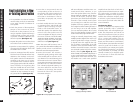
6
Introduction
Although the CM5PR and CM6PR have
extensive ability to compensate for unusu-
al placements with their unique pivoting
tweeters and acoustic fine-tuning switch-
es; placement is still the primary tool for
satisfying your particular listening needs.
In the following section, we discuss how
speakers should be placed and how tweet-
ers should be directed and how the
acoustic fine-tuning switches should be set
for different purposes.
Placement for Critical Listening
If you like to imagine that the band or
orchestra is playing in front of you as you
listen to music, or you are very conscious
of clarity, detail and the textures of the
individual instruments, or you listen criti-
cally to movie soundtracks or music
videos in your home theater, you will
need your speakers placed so that they are
optimized for critical listening. Here are
some guidelines to make the process of
placement quick and easy.
Make sure the sound will not be blocked
or reflected off of furniture or other
objects. You should have a direct line of
sight with the front of the speaker. To
determine the best position, measure the
“listening” distance between the ideal lis-
tening position (your favorite chair or
couch) and the location in which you plan
to install the speakers. Try to place the
speakers so that they are equally distant
from your listening spot and at least one
half of the listening distance apart (this
maintains a large pleasant stereo “image”).
In home theater applications where there
is a center channel you may choose to
space the left and right main speakers far-
ther apart for a “bigger than life” sound
with Dolby
®
encoded movies and TV
shows. However, for combined music and
movie usage stay within the good place-
ment zone for music. For example; if you
are ten feet back from the speakers, the
speakers should be between five and ten
feet apart (See Figure 4).
Tweeters should be directed at the listen-
ing position.
Speaker Placement
10'
5' 10'
Figure 4
In this example,
the speakers
could be
placed from
five to 10 feet
apart, since the
listener is 10
feet back from
the speakers
Direct tweeter
towards listener
Direct tweeter
towards listener
Critical
Listening
Position
Speaker Placement
17
Operations
Operation
Listening at Higher Volumes
It requires more power to achieve a reason-
able volume of sound in a large room than
it does in a small room. It is possible (even if
you are not a teenager) to turn the volume
so high that the amplifier runs out of power.
This creates “clipping” distortion.
Clipping distortion makes treble sound
very harsh and unmusical. When you hear
harsh sounding treble from any good
speaker, turn the volume down immedi-
ately! Those harsh sounds are masking
some much more powerful ultra-high-fre-
quency sound spikes which will quickly
damage any fine loudspeaker. You are
much less likely to damage a speaker with
a large amplifier because it will be very
loud indeed before it produces any clip-
ping distortion.
Cleaning
You can clean the speaker with a damp-
ened soft cloth or paper towel. If the
speaker is mounted high up on a wall or
ceiling, use a broom to gently brush it off.














